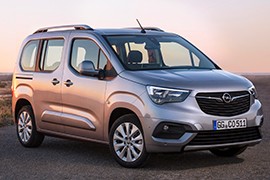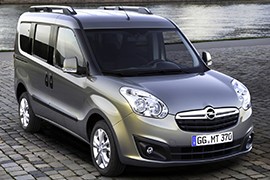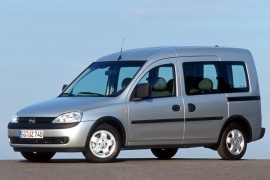OPEL Combo Models/Series Timeline, Specifications & Photos
First production year: 2001
Engines: Gasoline, Diesel, Natural gas
Body style: Van
Opel introduced the fifth generation of the Combo in 2018 based on the same platform as the French Citroen Berlingo and Peugeot Partner/Rifter.
While Opel built the first three generations of the Combo on its platforms, the fourth was a badge-engineered Fiat Doblo, one of the best-selling MPVs on its segment in Europe. For the fifth generation, things went differently after PSA (Peugeot-Citroen) bought the German carmaker. Thus, the 2018 Combo was a re-badged Citroen Berlingo-Peugeot Partner.
Like its French siblings, the 2018 Combo didn't look like a utility vehicle anymore. Even though it sported vertical side panels and a steep windshield, it looked more suitable to host people inside in e field trip than to a construction site. At the front, Opel designers made a broad grille with the company's logo on the upper side. The plastic bumper was tall and, on its lower side, it featured a trapezoidal grille flanked by two scoops where the carmaker installed the fog lights.
Inside, the Combo featured an interior inspired by the furniture world, and the designers made the cabin to be functional. Also, they took greater care of the material's quality, especially for the upper trim levels.
Since the platform is the same as the one from a passenger car, the ride was smoother. The available engines were a 1.2-liter gasoline engine with 110 hp mated to a 6-speed manual gearbox and another 1.2-liter turbo with 130 hp paired to an 8-speed automatic transmission. For diesel fans, there was also a 1.5 liter in three outputs versions: 75 hp, 100 hp, and 130 hp, respectively.
The German automaker introduced the third generation of its MPV Combo lineup in 2011, but it was more of a badge-engineered Fiat Doblo than an original Opel minivan.
Those were difficult years for the German automaker that was under GM's umbrella. Slow sales during the world financial crisis and the outdated lineup forced the American car manufacturer to put it up for sale. Eventually, that happened, and Opel ended up in a joint venture with Fiat and Peugeot-Citroen, and later on, it joined the Chrysler group that was later renamed Stellantis.
Even though it was built on the same platform and in the same factory as the Fiat Doblo, the Combo sported a unique front fascia that carried over Opel's specific design language. Thus, it featured a chromed trim at the top of the grille with the automaker's logo on it. Depending on the options, the front bumper was fitted with fog lamps in the side scoops that flanked the lower air intake that cooled the AC compressor. From its profile, the darkened A-, B-, and C-pillars created the image of a floating-roof design, while the rearmost post was body-colored. At the back, the car was fitted with either a vertical tailgate or side-hinged doors.
Inside, the automaker used the same interior as in the Doblo but with the Opel's badge on the steering wheel. Fronting the driver was an instrument cluster that featured large dials for the speedometer and tachometer and two gauges for the coolant temperature and fuel level. In addition, a small display placed at the bottom of the panel showed the odometer and the information for the trip computer. On the center stack, the high-mounted gear stick was handy. With seating for five and an option for two additional jump seats in the trunk area, the Combo proved to be a reliable partner for those looking for a family van/utility vehicle.
Power came from a choice of diesel or gasoline engines paired with a five or a six-speed manual, depending on the version.
The third generation of the Combo was no longer just a mundane utility vehicle with seats inside but rather an MPV that could have been used as an LCV.
While the first generation of the Combo was based on the same platform as the compact-sized Opel Kadett, the third generation was based on a stretched version of the Opel/Vauxhall Corsa platform. Even though that led to some minor compromises made in the commercial-vehicle version, the Combo was a better passenger-oriented car.
Sharing its front fascia with the Opel/Vauxhall Corsa was good. It sported an appealing design thanks to the new-edge design inspired headlights emphasized by the sharp angles and curved lines. The narrow, slatted grille was accompanied by a broader grille mounted in the apron. Unlike the Corsa, though, the Combo sported a much higher roof that was extended all the way to the back, where either a tailgate or two doors allowed the access to the trunk. In addition, gaining experience from its previous version, Opel decided to launch the vehicle with sliding doors that allowed an excellent ingress and egress to the car's cabin for the rear passengers.
Inside, the dashboard was carried over from the Corsa, with a small instrument cluster that comprised four dials for the speedometer, tachometer, plus fuel and temperature gauges. There was enough room inside for five adult passengers and plenty of room for the luggage behind the split-folding bench. The higher roof led to additional storage areas above the front seats.
Under the hood, the Combo had to rely on the Corsa's engine range. While the base version could hardly pull the vehicle fully loaded, the turbo-diesel version had no trouble at all doing it.


